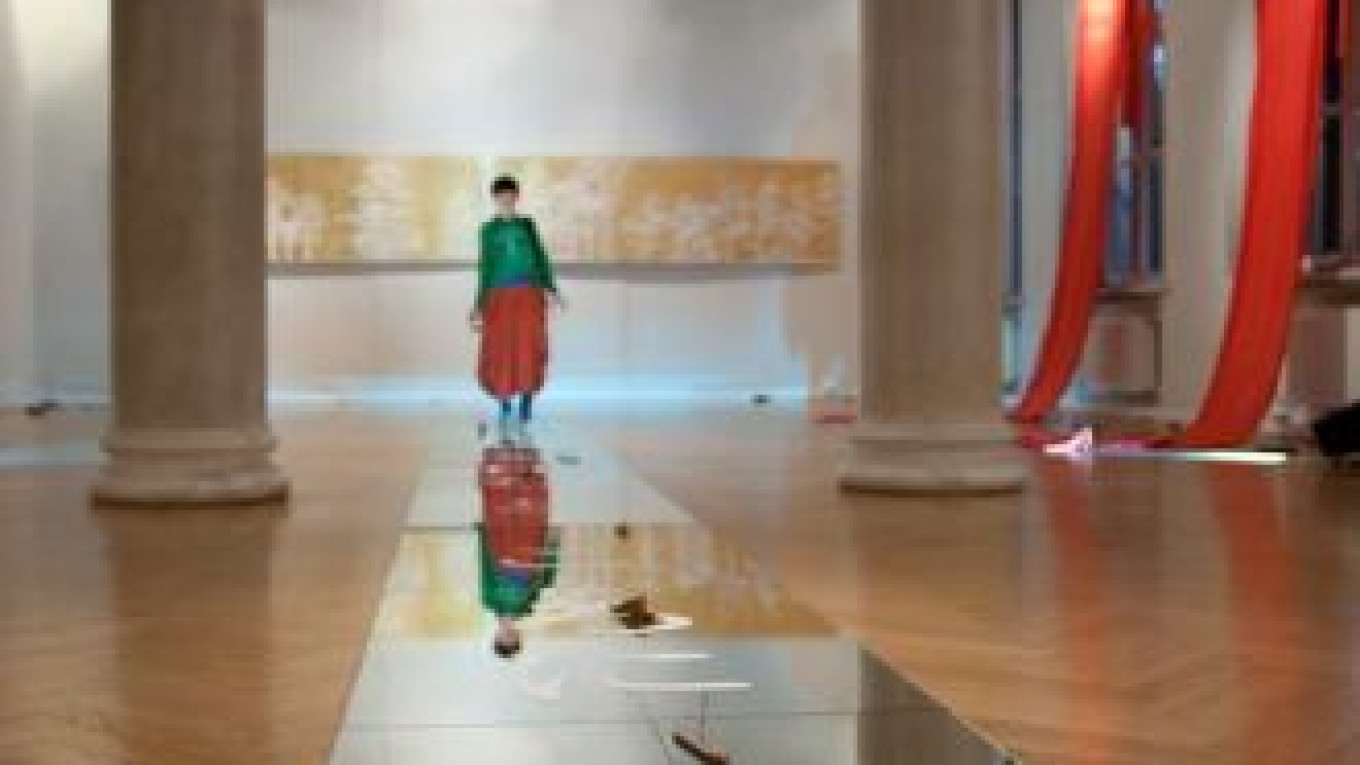Since the first appearance of the Moscow Biennale of Contemporary Art in 2003, the biennale has brought together local and foreign artists to show contemporary conceptual works for about a month or two every two years. This juxtaposition of well-known foreign artists and contemporary Russian artists creates new opportunities for both groups, and over the years personalities such as Anthony Gormley, Yoko Ono and Bill Viola have found themselves immersed in contemporary Russian art. This year, one of the special exhibits preceding the 5th Biennale is being held in the Museum of Contemporary History of Russia in the same hall as an exhibition of Russian folk crafts, inspiring the participants to create cross-cultural works.
This special project, "Roots, Growth — Us", contrasts between Russian and non-Russian groups and individuals. Works include paintings and digital prints of macro objects by Konstantine Malyutin, cubistic bromine prints by Vladimir Martynov, 3D works by Eva Bachmann, paintings by Gery De Smet, and wooden icebergs by the exhibition's co-curator, Moscow-based Japanese artist Mayuko Ogawa. Ogawa organized the participation of a Kyoto-based group, IPP, whose members are not only artists? but are also psychologists and scientists.
"When the Japanese group was invited to Russia, we hoped that mixing with Russian artists would give them a different perspective and inspire them. Art happens in your surroundings, so if you change the surrounding, it completely breaks the idea and gives room for experiment," Ogawa said to The Moscow Times.
‘Art happens in your surroundings, so if you change the surroundings, it …? gives room for experiment.’
Mayuko Ogawa
Japanese artists have always had a taste for combining new forms with traditional symbols. The IPP group deals with video, paintings, mirror reflections, cloth and wooden objects. It is common for contemporary art to use violent and provocative imagery, but IPP uses more subtle space in which symbols become hiding places for other symbols and reveal their essence in complex dimensions. One can recognize interpretations of ancient oriental silkscreens in works of Masako Yasuki, or, even more flattering, a meeting point between Russian and Japanese culture in "The Sacred Bells" by Minoru Morikawa, made of artifacts bought at a Moscow fair — cups, a faceted glass, vases and matryoshkas — connected to a five-yen bell tongue and a piece of paper with a poem on it. The center of the installation is a giant vertical mirror that projects a videoclip of "breathing" trees right on the surface of the Corinthian columns under the ceiling.
Visiting artists did consciously interpret Russian symbols — Belgian artist Gery De Smet placed a U.S.S.R. flag made out of confetti on the floor of the room, though the museum's administration forced him to install the flag on a pedestal rather than to put it directly on the floor.
The main project of the Biennale, called "More Light," will open Sept. 20 and last until Oct. 20, packing the Moscow Manege with works of 70 participants from 40 countries just to disassemble them a month later. The relevance of space and time has become a main criteria for the main project as well, as referred to Mikhail Bakhtin's concept of chronotope and rethought by the curator of "More Light", Catherine de Zegher.
Among the Biennale's special projects, "The Department of Labour and Employment" to be held in the State Tretyakov Gallery on Krymsky Val, will present the history of labor in Soviet and post-Soviet art from the 1960s to 2000s by collecting a variety of works from more than 60 individuals and art groups. During the exhibition, the Institute for retraining of modernist artists founded by Alexander Melamid will assist guest artists in employment, while the most creative ones will be able to attend training aimed at connecting Marcel Duchamp's classic "Urinal" to the plumbing systems of the Tretyakov Gallery.
In the Zurab Tsereteli Russian Academy of Arts, 20 artists from Italy will be creating an image of their native country. Additionally, a retrospective of the artistic protest movements in the Netherlands from the 1960s to 1990s will be on show at the Artplay Design Center. An overview of the Young British Artists movement will be presented in the Yekaterina Cultural Foundation.
"Roots, Growth — Us" runs from Sept. 12 to 28 in the State Museum of Contemporary History of Russia, 21 Tverskaya Ulitsa, 495-699-6724, sovr.ru. "More Light" opens Sept. 20 in Moscow Manege, 1 Manege Square, 495-645-9277, moscowmanege.ru. For more details on the projects of the 5th Moscow Biennale, visit 5th.moscowbiennale.ru/en.
Contact the author at [email protected]
A Message from The Moscow Times:
Dear readers,
We are facing unprecedented challenges. Russia's Prosecutor General's Office has designated The Moscow Times as an "undesirable" organization, criminalizing our work and putting our staff at risk of prosecution. This follows our earlier unjust labeling as a "foreign agent."
These actions are direct attempts to silence independent journalism in Russia. The authorities claim our work "discredits the decisions of the Russian leadership." We see things differently: we strive to provide accurate, unbiased reporting on Russia.
We, the journalists of The Moscow Times, refuse to be silenced. But to continue our work, we need your help.
Your support, no matter how small, makes a world of difference. If you can, please support us monthly starting from just $2. It's quick to set up, and every contribution makes a significant impact.
By supporting The Moscow Times, you're defending open, independent journalism in the face of repression. Thank you for standing with us.
Remind me later.


